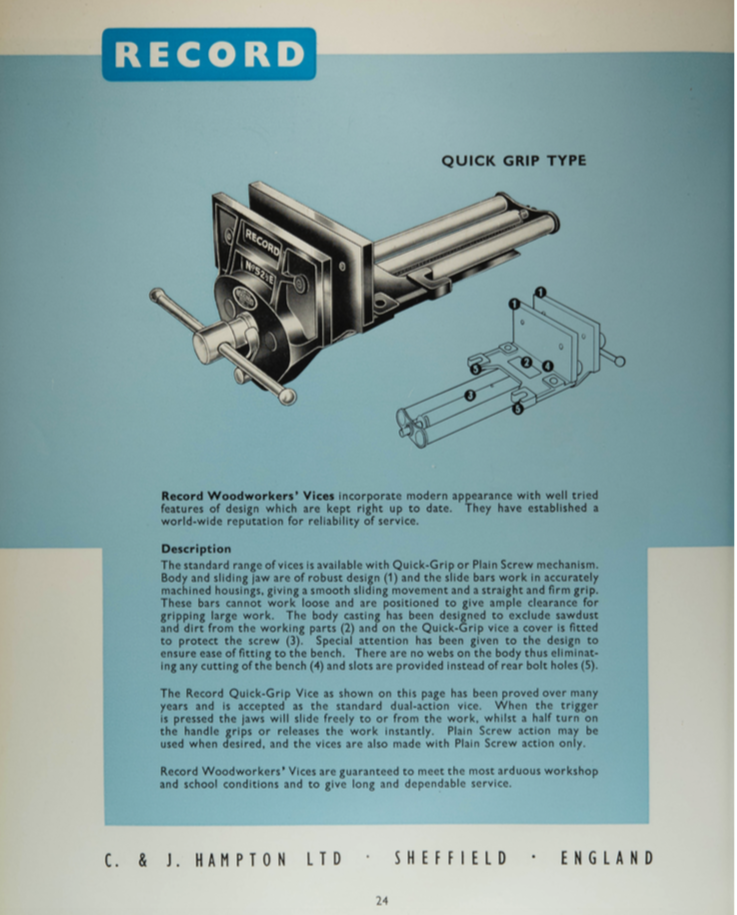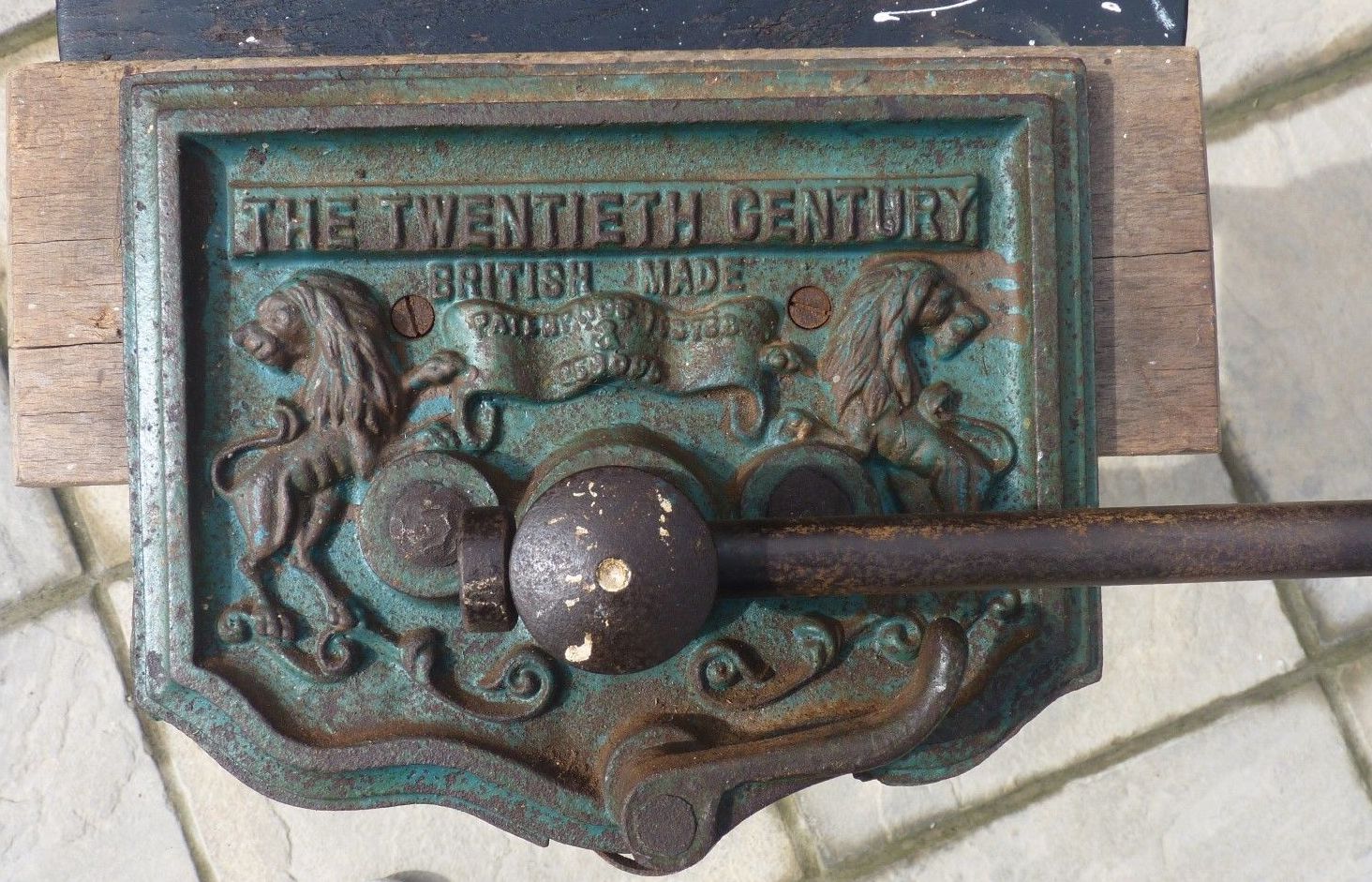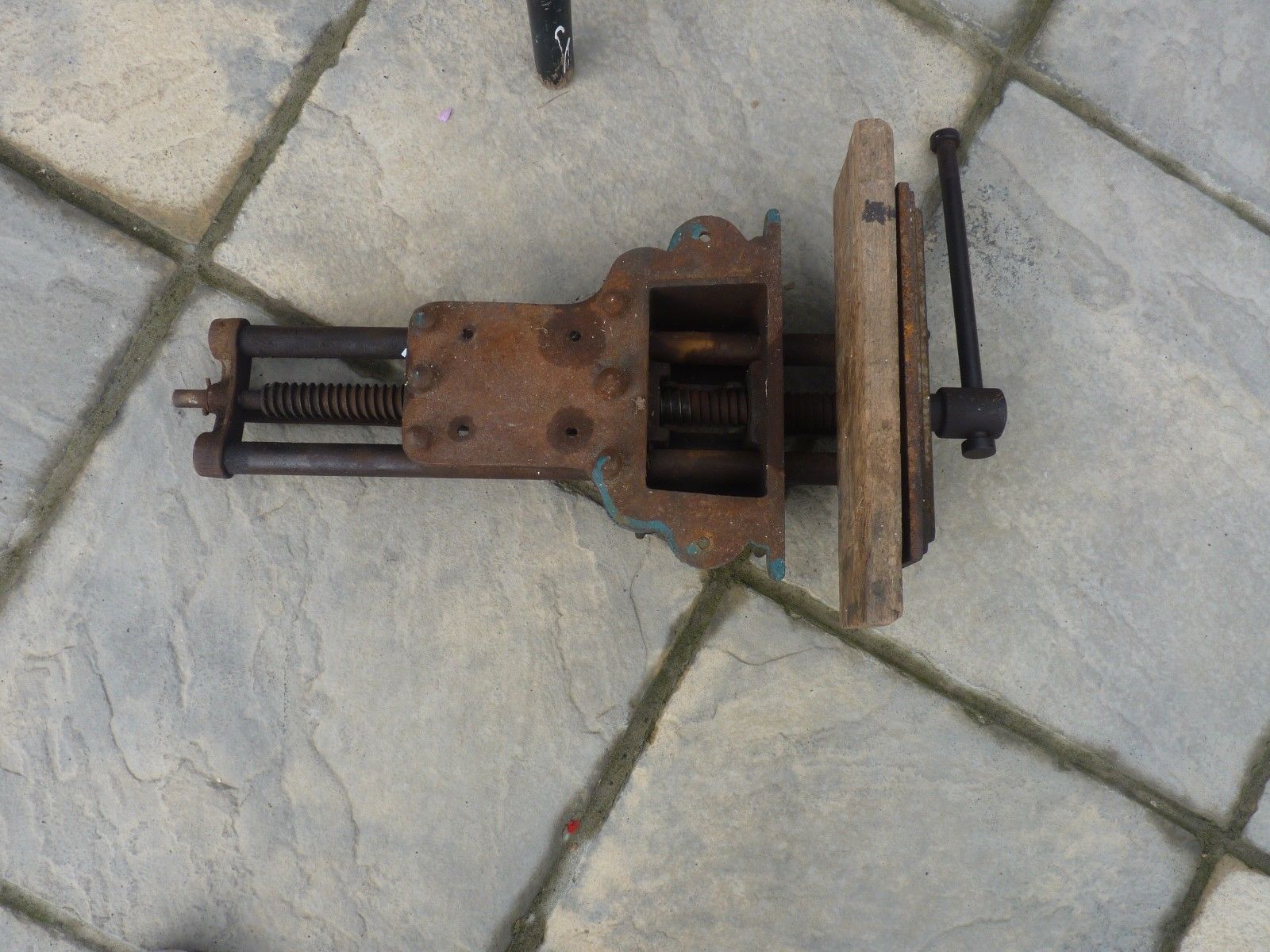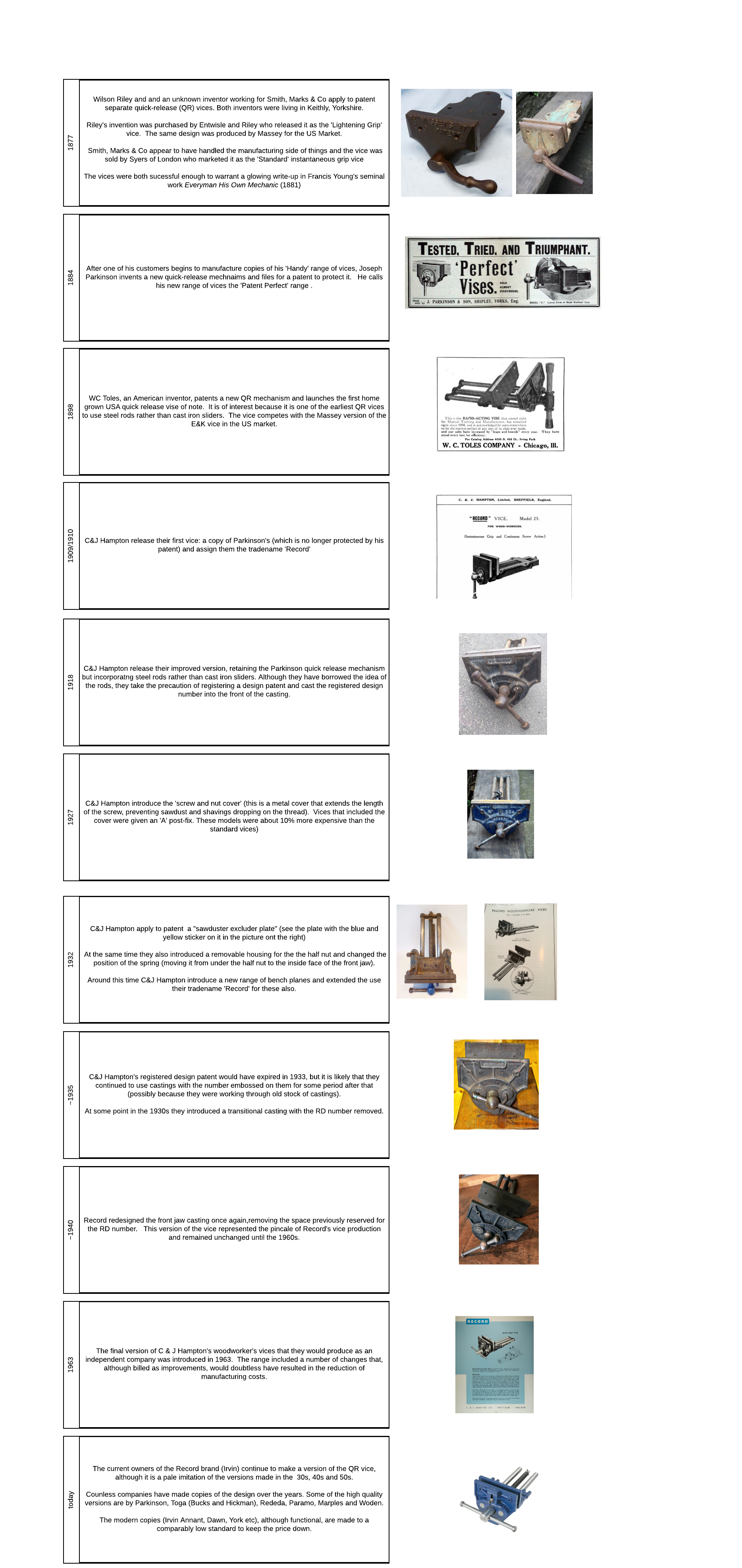You are using an out of date browser. It may not display this or other websites correctly.
You should upgrade or use an alternative browser.
You should upgrade or use an alternative browser.
Evolution of the Record 52 1/2 quick release vice
- Thread starter nabs
- Start date

Help Support UKworkshop.co.uk:
This site may earn a commission from merchant affiliate
links, including eBay, Amazon, and others.
right, we are lurching to the end of this survey - hold on to your hats!
although we have not managed to pin down an exact date for the previously described design, it was clearly a success and was produced unchanged for decades - in fact the next (and final) design change was not made until the 1960s. The changes made included:
On the cosmetic side, Record adopted a lighter blue colour and a new 'record' logo/sticker around this time and also came up with new post-fixes to describe the various models:
The new range was first announced in their 1963 catalogue:

As you can see the new range is deemed by Record to be an improvement on the previous version - I leave it to the reader to decide how many of these changes really do improve the design!
although we have not managed to pin down an exact date for the previously described design, it was clearly a success and was produced unchanged for decades - in fact the next (and final) design change was not made until the 1960s. The changes made included:
- * a new design for from face casting
* a new square boss (previously oval)
* the part holding the sliding bars parallel at the far end of the vice is now made of sheet metal (previously cast iron)
* the removeable steel 'sawdust excluder plate' in the rear carriage that covered the half-nut is gone and instead the casting is solid in this area
* the cast webs that braced the rear jaw and the horizontal face of the carriage are gone
* the two rear bolt holes in the carriage are now slotted
* The screw and nut cover that runs the length of the screw is now standard on all the QR models
* Finally, they introduced a new model that included a dog in the front jaw.
On the cosmetic side, Record adopted a lighter blue colour and a new 'record' logo/sticker around this time and also came up with new post-fixes to describe the various models:
- * P= plain screw
* C= combined vice and cramp for attaching/removing the vice
* E= Quick Release
* D= adjustable dog with QR (available as plainscrew too ('DP' although I think the castings were only marked D)
* no-postfix = lightweight plainscrew, 'amateur ' and junior range
The new range was first announced in their 1963 catalogue:
As you can see the new range is deemed by Record to be an improvement on the previous version - I leave it to the reader to decide how many of these changes really do improve the design!
Phil Pascoe
Established Member
My 53e must be a frankenvice - newer face design, square boss, screw cover, slotted bolt holes - but it has webs and a cast end.
I do think that those cosmetic changes were important at the time, when it really did matter that things should look modern, not old-fashioned. I can remember how as a teenager I looked down on the old wooden handles on my dad's tools and wanted all of mine to have superior plastic... 
If I had been buying a vice in the 70s I would have wanted a new one.
If I had been buying a vice in the 70s I would have wanted a new one.
Rhyolith
Established Member
How the wheels turn! Heritage, History and Conservation are a really big deal thesedays, think this is maybe linked to a disillusionement with the modern world and the apparent lose of things from the past (like practical skills). I notice modern tool companys will really make a deal out of tradition and heritage, to link themselves to a past commonly assocaited with superior practical arts possibly.AndyT":49dskqtm said:I do think that those cosmetic changes were important at the time, when it really did matter that things should look modern, not old-fashioned. I can remember how as a teenager I looked down on the old wooden handles on my dad's tools and wanted all of mine to have superior plastic...
If I had been buying a vice in the 70s I would have wanted a new one.
Wonder how long it will be before we all want new tools again... suppose many already do.
many plastic utilitarian objects are starting to be recognized as retro-classics - and rightly so, there is nothing inherently 2nd-rate about plastic as a material and it can be used to excellent effect. A good example are the rhubarb and custard handled stanley chisels which have now been around long enough to earn a nostalgic air.
Personally, if I ever see a Millers Falls drill or plane with permaloid handles I will buy it like a shot!

Personally, if I ever see a Millers Falls drill or plane with permaloid handles I will buy it like a shot!


£96.66
£102.61
O'SKOOL Mortise and Tenon Jig is Ideal for cabinets, Chairs, and Table Construction Using a Plunge Router
Amazon US

£400.66
Trend Portable Benchtop Router Table with Robust Construction for Workshop & Site Use, 240V, CRT/MK3
Qwikfast Trade & DIY Supplies Limited

£13.99 (£2.80 / count)
VEVOX® FFP1 Dust Mask - Set of 5 - Valved Face Masks - Respirator - Protection e.g. for Construction, Building Work, Sanding, Woodworking, Fine Dusts, Aersoles or Particles
SLSK Ventures GmbH (UK)

£12.50 (£1.25 / count)
£14.45 (£1.44 / count)
JSP M632 FFP3moulded Disposable Dustmask (Box of 10) One Size suitable for Construction, DIY, Industrial, Sanding, dust protection 99 Percent particle filtration Conforms and Complies to EN 149
Amazon.co.uk

£17.99 (£9.00 / count)
JORGENSEN 300mm Professional Woodworking Clamps 2 Pack, Quick Release Clamps for Wood, F Clamps Set
GreatStarTools

£17.99 (£1.80 / count)
£27.44 (£2.74 / count)
3M 8822 Disposable-fine dust mask FFP2 (10-pack)
Amazon.co.uk
toolsntat
Yep, I collect tools and tat
nabs":oh46hj62 said:I had a closer look at the rods on mine and the first thing I noticed is that they are not flush with the surface - one is slightly recessed and there is a thin edge of steel that seems to have been raised along one side of the hole which might be an indication that it was somehow peened to fit. I suppose they must have had some clever way to stop the rods bending/case cracking when they did this.

An observation on this occurrence Nick if I may.
In my experience I have found the bars to be screwed into the front jaw.
The ribbed peaning thus preventing them from unscrewing.
Have you tried screwing that one back in at all?
Any slight unscrewing with wear could cause that burr to occur.
Cheers
Andy
never one to leave a dead horse unflogged, I was looking into whether there were any significant improvements to Record's design from the 1920s/30s. The short answer seems to be 'no' - the Record QR is a lulu.
However, I think an honourable mention should go to the 'Twentieth Century' vice that, should you have seen one, you will surely remember:

Bugbear in an earlier discussion ((old-vice-t73056.html)) did all the leg work to uncover the history - there are two patents for the vice taken out by Abraham Chris, a Russian immigrant living in Brick Lane London:
https://worldwide.espacenet.com/publica ... cale=en_EP
https://worldwide.espacenet.com/publica ... cale=en_EP
The earlier patent from 1922 describes a base plate designed to simplify the attachment of the vice to a bench, and the second is a modification to accomodate a QR mechanism.
I mention it now because one recently came up on an ebay and we can see what Mr Chris was up to:

Although the patent describes a base-plate with one or more transverse ribs that engage with corresponding mortices on the underside of the bench, the actual implementation is a series of raised pointed cylinders. This seems like a decent idea since you could use the points to mark the underside of the bench and then drill holes rather than chopping a mortice.
Fair play to Mr Chris for getting someone to make them for him and selling a few. Extra plaudits for naming the vice 'The twentieth Century' and then coming up with an ornate face that harks back to the 18C. The few that have appeared online are all different colours, so it is not possible to be sure what they originally looked like - hopefully they were suitably garish!
However, I think an honourable mention should go to the 'Twentieth Century' vice that, should you have seen one, you will surely remember:
Bugbear in an earlier discussion ((old-vice-t73056.html)) did all the leg work to uncover the history - there are two patents for the vice taken out by Abraham Chris, a Russian immigrant living in Brick Lane London:
https://worldwide.espacenet.com/publica ... cale=en_EP
https://worldwide.espacenet.com/publica ... cale=en_EP
The earlier patent from 1922 describes a base plate designed to simplify the attachment of the vice to a bench, and the second is a modification to accomodate a QR mechanism.
I mention it now because one recently came up on an ebay and we can see what Mr Chris was up to:
Although the patent describes a base-plate with one or more transverse ribs that engage with corresponding mortices on the underside of the bench, the actual implementation is a series of raised pointed cylinders. This seems like a decent idea since you could use the points to mark the underside of the bench and then drill holes rather than chopping a mortice.
Fair play to Mr Chris for getting someone to make them for him and selling a few. Extra plaudits for naming the vice 'The twentieth Century' and then coming up with an ornate face that harks back to the 18C. The few that have appeared online are all different colours, so it is not possible to be sure what they originally looked like - hopefully they were suitably garish!
Paul200
Established Member
What a fascinating read. Just been looking around online for some way of dating 52 1/2 vices and found this 'under my nose', so to speak!
The info in this thread helped me a lot today in trying to decide which 52 1/2 vice to buy. Thanks Nick and others.
Paul
The info in this thread helped me a lot today in trying to decide which 52 1/2 vice to buy. Thanks Nick and others.
Paul
This is my recently aquired 52 1/2,
I've gone through the whole thread, reading some posts more than once but,
could not figure out exactly how old is my Record ...
From what I read I guess it is pre 1960, can any of you help in further restricting its age ?
I've gone through the whole thread, reading some posts more than once but,
could not figure out exactly how old is my Record ...
From what I read I guess it is pre 1960, can any of you help in further restricting its age ?
Attachments
Paul200
Established Member
It has the patent number on the face so I'm guessing pre 1934 (ish) - see Nick's post at the top of page 4 of this thread. Well done! I've just bought one that dates somewhere between yours and 1960.
Paul
Paul
given the disjointed nature of these posts I thought it would be handy to have a summary timeline which I have reproduced below - this is the nearest I could get to a type study:

PS I also cleaned up the original posts and put them in a more sensible order on my blog (there is a bit of new content but not worth reading if you already waded through this lot!)
cheers
PS I also cleaned up the original posts and put them in a more sensible order on my blog (there is a bit of new content but not worth reading if you already waded through this lot!)
cheers
Rhyolith
Established Member
Really like this timeline, thank you!
toolsntat
Yep, I collect tools and tat
[quote #1183158 quote]
Hi Squib, could you please tell me if when you remove the sliding jaw there is a separate unattached part ?
I assume that this is lifted by the cam to engage with the fixed part ?
Cheers Andy
squib":2v9k0g7e said:Fascinating thread, thank you for posting your research.
A quick pic of my instanteneous vice, no makers name but patented..
Hi Squib, could you please tell me if when you remove the sliding jaw there is a separate unattached part ?
I assume that this is lifted by the cam to engage with the fixed part ?
Cheers Andy
dannyr
Established Member

Hello - I'm a new member today, much liking your posts --
but not managing the system for attachments v well - even after resizing seems to only allow me one - is this correct? oh and where do I find my saved draft? this is the 3rd try, each attempt briefer.
anyway here's the very heavy 8 1/4" wide Syers -- J Syers London model 2A patent -- that I have on my bench as a front vice --- works just fine - I love to have a century++ old working vice.
I have a Parkinsons Perfect 10 1/2" first version (3 screw holes, long base, very heavy) as an end vise - also works just fine ditto for this (couldn't upload pic, even after resizing to <2M)
Anyhow - regards to all - this seems like a helpful and friendly site
rgds
danny (Sheffield, UK)
Attachments
dannyr
Established Member

and here is the Parkinsons Perfect Vise 10 1/2" (first version, I believe, heavy, long base, 3 front plate screw holes) which is the end-vice for my bench. It also works very well.
I finally finished the bench last year - solid beech top (from saw-mill in 1989) and oak base (from door frame made in 1865) immodestly proud (my heirs will have to figure how to get it out of the cellar workshop - the top unbolts, but weighs a ton (not quite)).
looks fine outside, so off to the allotment
danny




























